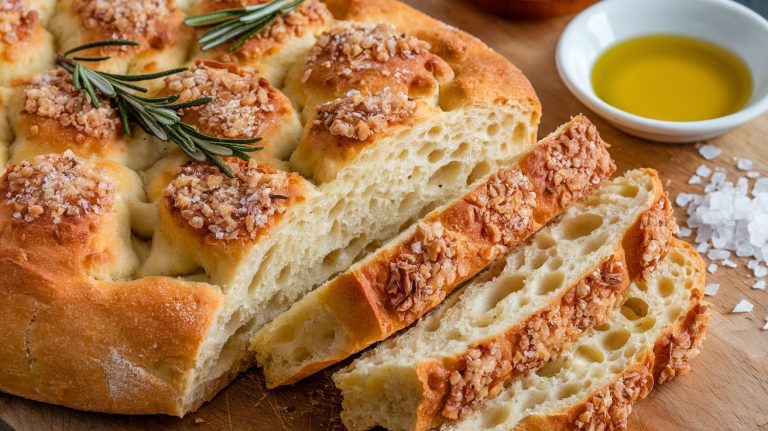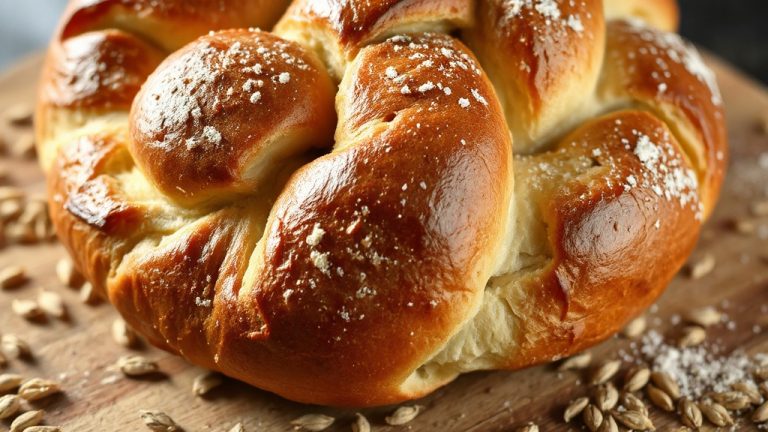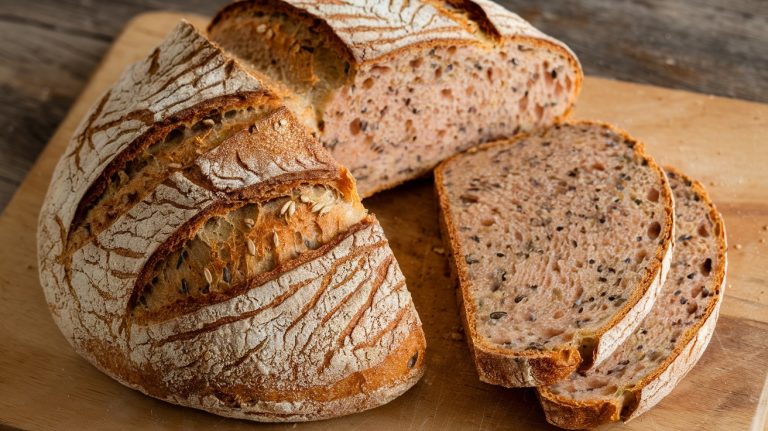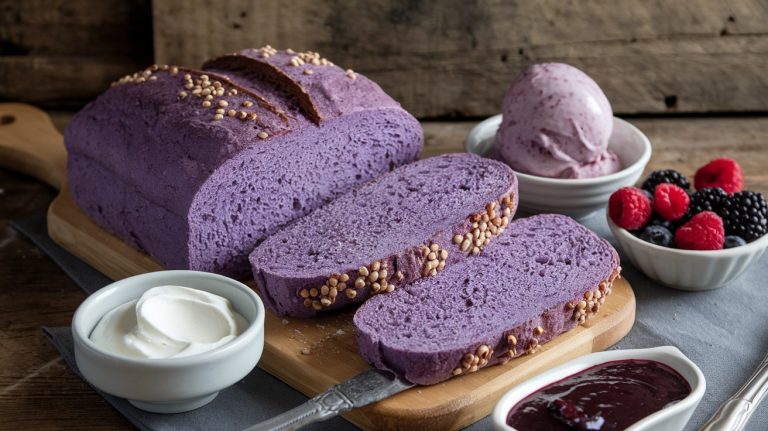Open Crumb Sourdough Recipe: Achieve Bakery-Quality Results
To get an open crumb in sourdough, use high-protein bread flour (11–13%) for strong gluten.
Maintain about 70% hydration to keep the dough wet but manageable. Incorporate autolyse and stretch-and-folds during bulk fermentation at around 75°F to strengthen gluten without degassing.
Shape gently to preserve gas bubbles and score precisely for controlled oven spring. Bake with steam at 230–250°C to maximize rise and crust.
Follow these steps closely to understand how each factor influences crumb openness.
Key Takeaways
- Use high-protein bread flour (11%-13%) for strong gluten and better open crumb structure.
- Maintain 65%-75% dough hydration to balance dough strength and openness.
- Perform autolyse and regular stretch-and-folds during fermentation to develop gluten and gas retention.
- Shape gently with proper tension, rest dough, and score shallowly to control oven spring.
- Bake with steam at 230-250°C (450-480°F) for 10-15 minutes, then finish dry for a crisp crust.
Essential Factors For Open Crumb Sourdough Success
| Key Factor | Recommended Range/Method | Purpose | Impact On Crumb |
|---|---|---|---|
| Flour Protein Content | 11-13% bread flour | Builds strong gluten network | Creates structure for large air pockets |
| Hydration Level | 65-75% | Balances manageability and openness | Produces airy, tender crumb |
| Fermentation Temperature | 75°F (24°C) | Optimizes yeast activity | Controls gas production and rise |
| Bulk Fermentation | Monitor volume, avoid over-fermentation | Develops flavor and structure | Ensures even air distribution |
| Dough Strengthening | Stretch-and-folds, lamination | Traps gases, builds surface tension | Maintains open structure |
| Shaping Technique | Gentle boule or batard method | Preserves gas bubbles | Supports maximum oven spring |
| Scoring Method | Sharp blade, shallow angle | Creates controlled expansion | Promotes predictable bloom |
| Baking Temperature | 230-250°C (450-480°F) initial | Activates rapid oven spring | Develops open crumb structure |
| Steam Duration | First 10-15 minutes | Keeps crust moist and elastic | Enables maximum expansion |
| Cooling Time | 1-2 hours on wire rack | Stabilizes crumb starches | Preserves texture and structure |
Selecting the Right Flour for Open Crumb
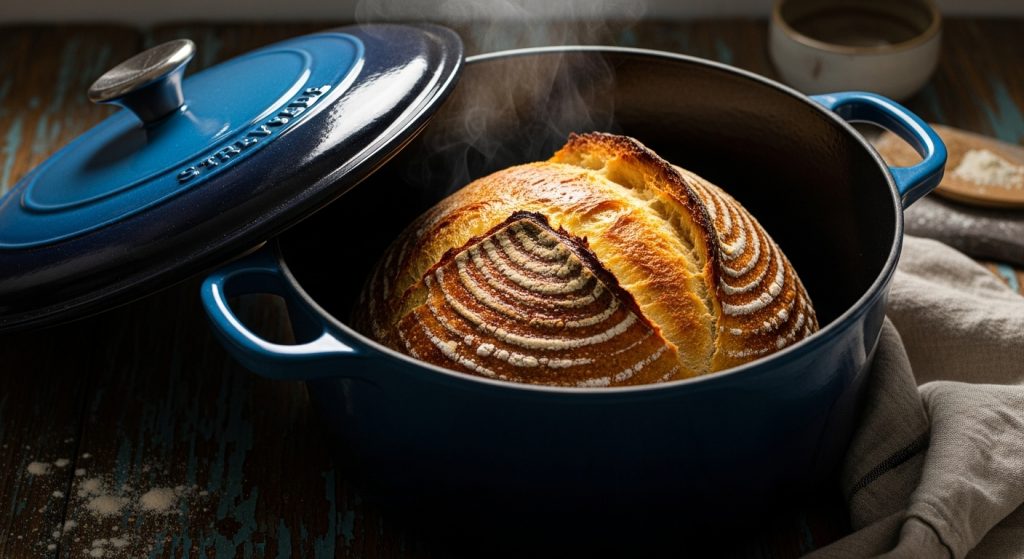
When selecting flour for an open crumb sourdough, you should prioritize protein content between 11% and 13%. This range supports the development of a strong gluten network capable of trapping gas bubbles and creating large air pockets. High-protein flours such as Bobs Red Mill Artisan Bread Flour are excellent choices for achieving this structure.
Bread flours, like King Arthur Bread Flour at 12.7% protein, offer ideal gluten strength.
King Arthur Bread Flour, with 12.7% protein, provides optimal gluten strength for open crumb sourdough.
All-purpose flour around 11.7% protein can work but often requires blending with higher-protein bread flour to improve openness.
Whole wheat flour, despite higher protein (~13%), contains bran and germ particles that physically cut gluten strands, reducing extensibility and resulting in a denser crumb.
To maintain gluten integrity, you should limit whole wheat proportions or use finer-milled flours such as Italian type 0 or 00.
These enhance dough extensibility, encouraging a more open crumb structure.
Choosing white flour is common because it balances flavor and nutrition with the desired crumb structure.
Mastering Hydration and Dough Handling
Although achieving an open crumb often hinges on hydration levels, mastering both hydration and dough handling is essential to control dough strength and gas retention. These factors directly influence the crumb’s openness and texture.
You should aim for 65%-75% hydration to balance dough manageability and crumb openness. Gentle handling preserves gas bubbles, while shaping creates surface tension to support structure. It is important to include starter hydration in your water and flour calculations to ensure accurate dough consistency.
The fermentation process in sourdough can lower the glycemic index, benefiting health-conscious bakers.
Strengthen high hydration doughs via stretch and folds or lamination to trap gases effectively.
| Aspect | Technique | Impact |
|---|---|---|
| Hydration Level | 65%-75% | Airy, tender crumb |
| Dough Handling | Gentle shaping | Preserves bubbles |
| Strengthening | Stretch & folds, lamination | Traps gas, maintains structure |
| Surface Tension | Proper shaping | Supports open crumb |
Perfecting Fermentation for Optimal Texture
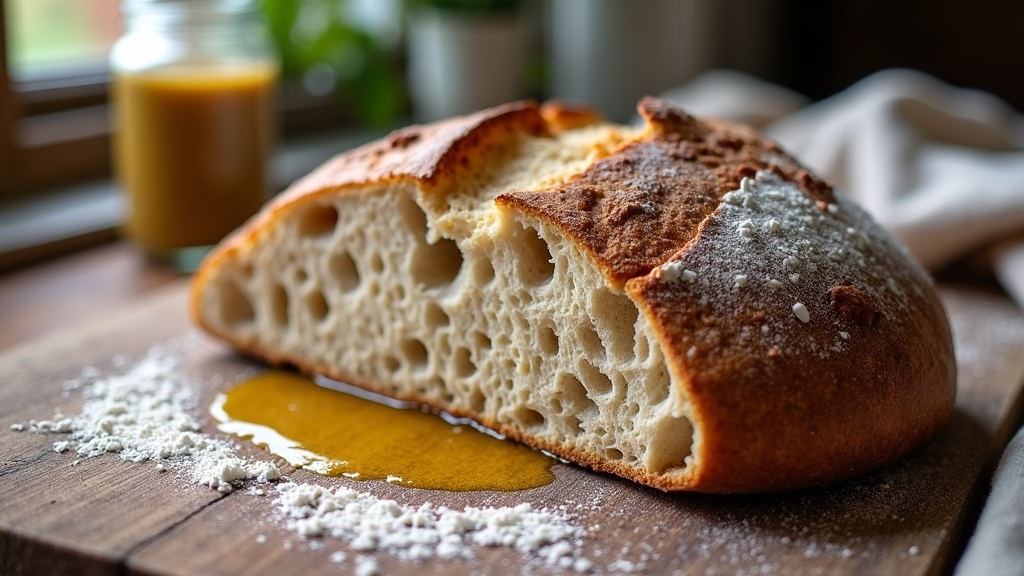
Since fermentation profoundly influences dough structure and crumb texture, perfecting its parameters is essential for an open, airy sourdough crumb.
Start by maintaining your starter through twice-daily feedings at 74°F–78°F (23–25°C). Use it when risen, bubbly, and pleasantly sour but not over-acidic.
Avoid over-fermentation to prevent protease overactivity, which weakens gluten. During bulk fermentation, keep the dough at about 75°F (24°C) and perform regular stretch-and-folds to evenly distribute yeast and control air pockets. Practice and repetition are key to mastering these folding techniques and achieving consistent results.
Monitor dough volume carefully, adjusting timing to optimize growth without collapse. Incorporate autolyse to hydrate flour fully and weaken gluten slightly, enhancing oven spring and crumb openness.
Finally, select flour with appropriate protein content and enzymatic activity to support fermentation and structure. Balance hydration to maintain dough strength for an ideal open crumb texture.
Shaping and Scoring for Best Results
Mastering shaping and scoring techniques directly influences the sourdough’s final oven spring and crumb openness by controlling dough tension and gas retention. Using proper shaping methods also helps maintain an even gluten development, which is crucial for the desired crumb texture.
Use the boule method with strategic folds or shape into a batard to optimize tension distribution, supporting a lighter crumb. These shaping techniques are enhanced when dough is mixed and kneaded effectively with a stand mixer, ensuring consistent dough strength.
Pre-shape gently to preserve gas pockets, then rest the shaped loaf seam side up for 5–10 minutes to secure the seam and maintain structure.
Handle the dough firmly but gently to avoid gas loss. Proper dough handling techniques, such as the slap and fold method, promote gluten development and improve dough strength.
Score just before baking with a sharp blade at a shallow angle, creating controlled release points that promote predictable expansion without tearing. Scoring is vital to allow steam to escape and develop a beautiful crust during the high-temperature baking process.
Employ double scoring to increase surface area for bloom.
Confident, precise strokes prevent dough drag and preserve internal gas, essential for an open, airy crumb and robust oven spring.
Baking and Cooling Techniques for Crust and Crumb

When you bake sourdough at an initial temperature between 230-250°C (450-480°F), you activate the oven spring essential for developing an open crumb and a well-structured crust. Open crumb features large, even holes throughout the bread, known as alveoli, resulting from effective fermentation, which this baking temperature helps to encourage.
Using a digital baking scale ensures precise ingredient measurements that contribute to consistent fermentation and crumb structure. Introduce steam during the first 10-15 minutes to keep the crust surface moist and elastic, enabling maximal expansion and starch gelatinization for a thin, glossy crust.
Steam early in baking keeps the crust moist and elastic, promoting maximum rise and a glossy finish.
After steaming, switch to a dry, hot phase to crisp and color the crust without collapsing the crumb. Achieving an open crumb also depends on using higher hydration levels during dough preparation to promote gas retention and crumb openness.
Once baked, cool your loaf on a wire rack at room temperature for 1-2 hours to prevent moisture buildup that softens the crust.
Avoid slicing while hot to allow crumb starches to stabilize.
Gentle handling during cooling preserves the fragile crumb and maintains crust crispness, ensuring an ideal texture contrast between crust and crumb.
Frequently Asked Questions
Can I Use Sourdough Discard in This Open Crumb Recipe?
Yes, you can use sourdough discard in your open crumb recipe, but expect slower fermentation and potentially tighter crumb.
You’ll need to extend bulk fermentation, adjust hydration carefully, and possibly increase fresh starter or levain to boost yeast activity.
Incorporate an autolyse for better gluten development and use gentle folding to strengthen the dough.
Monitor proofing closely to avoid overproofing, and consider shaping methods that enhance gas retention for ideal crumb openness.
How Do I Store Open Crumb Sourdough Bread for Best Freshness?
To keep your open crumb sourdough fresh, cool it completely on a rack first. Store it cut-side down on a wooden board to maintain crumb moisture and crust crispness.
Cover it loosely with a cake dome or large bowl for airflow. Use a bread box for stable humidity. Avoid plastic wrap, which softens crusts.
For longer storage, freeze the loaf in airtight bags. Thaw at room temperature or reheat to restore freshness.
What Tools Are Recommended for Scoring Open Crumb Sourdough?
You should use a bread lame or a razor blade for scoring open crumb sourdough because their sharpness guarantees clean, precise cuts.
X-acto knives work well for detailed designs, while scissors help with small adjustments.
Maintain a sharp blade and score with confident, continuous strokes about 1/2 inch deep.
Dust the dough lightly with flour to improve contrast.
These tools and techniques help control oven spring and achieve well-defined expansion.
Can I Substitute Commercial Yeast for Sourdough Starter?
Substituting commercial yeast for sourdough starter is like swapping a symphony for a solo instrument. It speeds up fermentation but loses complexity.
You’ll need much less commercial yeast due to its higher activity, and proofing times will shorten drastically.
However, expect milder flavor, reduced digestibility benefits, and a less open crumb.
Adjust hydration and timing carefully.
Direct substitution without tweaks can compromise texture and nutritional value markedly.
How Do Altitude Changes Affect Open Crumb Sourdough Baking?
Altitude changes speed up fermentation due to lower air pressure and faster gas expansion, so you’ll need to reduce yeast or starter amounts and shorten proofing times.
Dry air demands higher hydration, around 70-75%, to maintain dough moisture.
Increase oven temperature by 25°F and extend baking time to compensate for lower boiling points and heat transfer.
Incorporate extra stretch-and-folds to strengthen gluten quickly, preventing overproofing and ensuring an open crumb structure.
Bake Your Best Open Crumb Loaf
By choosing flour with the ideal protein content and managing hydration meticulously, you set the stage for that coveted open crumb.
Gentle handling and precise fermentation coax the dough into its best form, while thoughtful shaping and scoring guide its final rise.
Baking at the right temperature and allowing proper cooling complete the transformation.
Though the process may seem intricate, each step subtly unfolds, revealing a loaf that’s as much a technical triumph as a delicious reward.



